Six decades of design were presented at the Sydney Design Festival at NIDA, in conversation, reflection and projection
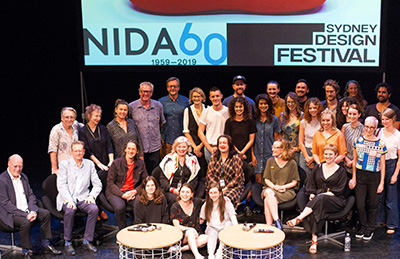
Above: the panellists of NIDA Alumni from the 1960s to 2019 and current NIDA Design students at Accessing Design Excellence and Sydney Design Festival at NIDA. (All photos: Zelman Cowan)
As part of its 60th birthday celebrations and in collaboration with the Sydney Design Festival, NIDA presented a one-day seminar on Design Excellence. The event attracted teachers, designers, directors and future leaders and included contributions from the wealth of experience of leading practitioners. The seminar made connections across six decades in conversation, reflection and projection and ended with a panel made up of recent NIDA Design graduates.
Dr Julie Lynch APDG, the sixth head of design at NIDA, and the first female, opened the seminar, and explained that since the design course began at NIDA in 1972, it developed from a Diploma to a Bachelor of Dramatic Arts in Set and Costume Design, to a Bachelor of Fine Arts and Master of Fine Arts Design for Performance, including Set, Costume and Lighting Design.
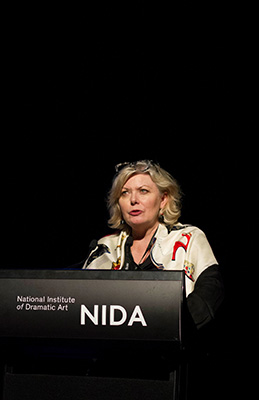
Above: Dr Julie Lynch APDG, Director, Centre for Design Practices, NIDA and 1980s Panel Chair.

Above: Stephen Curtis APDG, Senior Lecturer, NIDA and 1960s – 70s Panel Chair.
Dr Lynch acknowledged NIDA’s previous Heads of Design – Arthur Dicks1971 (Head of Production, then Design) to 1974, Allan Lees OAM1975 to 1981, Robin LovejoyOBE 1982 to 1985, DrPeter Cooke AM 1986 to 2008, Michael Scott-Mitchell APDG 2008 to 2017.
‘NIDA’s international and national design legacy is one of the largest jewels in its crown” said Dr Lynch. “Our graduates work as set, costume and lighting designers for both live and screen industries with some the most innovative theatre companies across the world, in the finest theatre venues and on some of the largest film projects – yet they also work as Artistic Directors, Producers, Film Directors, Festival Directors, fine artists, directors, and writers. NIDA’s reputation for Design excellence has been acknowledged through international and national awards, including Academy, BAFTA, Tony and Helpmann awards. There is no other Design for Performance course in Australia that has such a pedigree of national and international achievement and recognition.’
‘As I invited our Design alumni to take part in today’s forum, I learned of the exciting and diverse projects that NIDA grads were involved in, Fiona Crombie had just won a BAFTA for her production design for The Favourite, Game of Thrones’ Deborah Riley had just moved to LA to work on her next top secret production design; Academy Award nominee Michael Wilkinson was designing a fantasy musical for Netflix; Pip Runciman APDG was just winding down from her role as Designer for Sydney Festival, Jake Nash was in the process of developing a First Nation creative collaboration with Bangarra, Canada and New Zealand, Dane Laffrey had recently been nominated for a Tony Award, Kym Barrett had just received a Costume Designer’s Guild nomination for her scifi/fantasy work on Aquaman. Michael Scott-Mitchell was designing the next digital Opera Madama Butterfly for Opera Australia. This is a small snapshot of the lives of NIDA’s leading design alumni.’
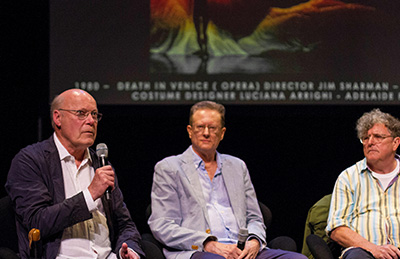
Above: Jim Sharman, Kim Carpenter AM, APDG and Eamon D’Arcy speak in the 1960s – 70s panel.
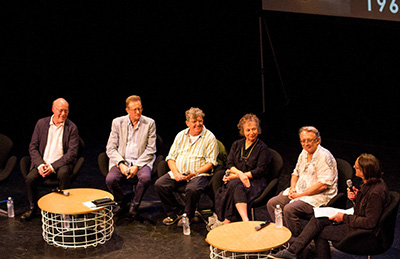
Above: Jim Sharman, Kim Carpenter AM, APDG and Eamon D’Arcy, Edie Kurzer , Bill Haycock and Stephen Curtis speak in the 1960s -70s panel.
The panel sessions began in the 1960s-1970s, at a time when Australian theatre-makers and theatres were asserting their creative identity. NIDA was founded in 1959, and that decade saw the first Australia Council for the Arts, the opening of the Sydney Opera House, theatres such as the Nimrod committed to Australian work and the formation of the new Designers Association for the Performing Arts to represent Australian designers’ interests. Stephen Curtis APDG chaired a discussion around this decade which saw a ‘new wave of Australian theatre-makers’ heralded by Jim Sharman’s production of Hair in 1969 and Kim Carpenter’s designs for Rick Billinghurst’s The Rake’s Progress in the same year.
‘The ideas of Brecht and Meyerhold had finally made it onto Australian stage – 60 years late. As our panelist Bill Haycock put it: [they] “dragged Australian stage design screaming into the twentieth century.’
As the seminar moved through the decades, the panelists were engaged in vibrant and at times humorous debate on a wide variety of issues.
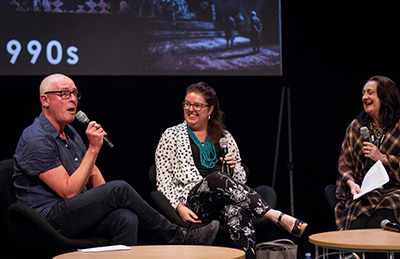
Above: Peter England, Fiona Donovan APDG and Dr Suzanne Osmond speak in the 1990s panel.
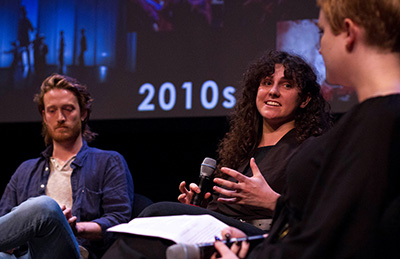
Above: Christopher Baldwin, Charlotte Mungomery and Sabina Myers speak in the 2010s panel.
The panel on the 1980s reflected on how the role of designer has changed and the impact of technology. The discussions around the last decade of the 20th century were characterised by theintegration of digital technologies into all aspects oflife, and the broadening of design students’ horizons to include large scale international events and the globalmovie industry. At this time, the new facilities and theatre spaces at NIDA’s Kensington campus gave focus to the strengthening of theimportant networks and mentor relationships that existed within and around the NIDA community.
The2000s panel explored key themes influencing designers: therapid development ofdigital technologies, climate change andsustainability, interdisciplinary practice (mobility across live performance and screen),and the evolvingperceptions of the designer’s role. The final panel on the 2010s discussed around design now and into the future, and focused on how current technologies and the socio-economic climate impacts on the work designers make.
Other issues throughout the day included changing fee structures and agreements for designers, new markets and content providers such as Netflix and Stan in Australia, changing techniques and resources, the responsibility to design more ethically and sustainably, designing on paper or digitally, and the more recent “stage and screen ever cross-pollinating” as Sabina Myers said. Social responsibility and diversity in representation were also current issues that engaged the panel and the guest contributors.
Dr Julie Lynch finished the day with this advice from NIDA Alumni and BAFTA Award winning Deborah Riley. ‘Don’t just work hard, give it everything you’ve got. Be brave. Be a kind and generous person to work with. Be loyal and when you find the good people – stick with them.’
For more information about or to register your interest in NIDA’s Bachelor of Fine Arts (Design for Performance) or Master of Fine Arts (Design for Performance) go to apply.nida.edu.au
The panel attendees and guest contributors included:
- Alice Babidge, Stage and screen designer
- Bill Haycock, Australian opera and theatre costume and set designer
- Catherine Martin APDG, Designer Stage and Screen and Academy Award winner
Charles Davis, Designer and guest design lecturer - Charlotte Mungomery, Designer
- Christopher Baldwin, MFA Design student
- David Fleischer, Designer and guest design lecturer
- Deborah Riley APDG, Award-winning screen production designer
- Dr Amanda Morris the Executive Director for NIDA’s Conservatoire
- Dr Julie Lynch APDG, Director, Centre for Design Practices, NIDA
- Dr Peter Cooke AM, former Head of Design, NIDA, current Professor and Head of School of Drama, Carnegie Mellon University
- Dr Suzanne Osmond, Senior Lecturer and Course Leader, Graduate Studies, NIDA
- Dale Ferguson, Designer and Tony Award nominee
- Dane Laffrey, Designer NYC
- Eamon D’Arcy, Set, commercial and event designer
- Edie Kurzer, award-winning costume designer
Elizabeth Gadsby, designer and Sydney Theatre Company resident designer - Fiona Crombie, BAFTAaward-winning and Oscar nominated screen production designer
- Fiona Donovan APDG, screen designer and APDG Vice President
- Gabrielle Rowe, MFA Design student
- Jake Nash, Designer
- Jenny Bott AO, Executive Chair of the NIDA Board
- Jeremy Allen, Designer and design lecturer
- Jim Sharman, Director and Artistic Director
- Justin Nardella, Designer
- Kim Carpenter AM, APDG, Australian theatre director, designer and Artistic Director of Theatre of Image
- Michael Hankin, Designer and Guest Lecturer
- Michael Agosta, Designer
- Nick Dare, Designer and guest lecturer
- Peter England, Designer and guest lecturer
- Pip Runciman APDG, Designer
- Sabina Myers, Designer and guest lecturer
- Stephen Curtis APDG, Senior Lecturer, NIDA
- Simone Romaniuk, Designer
- Tess SchofieldAPDG, Costume designer
- Tim Ferrier APDG, Screen production designer
- Tobhiyah Stone Feller, Designer and Lecturer Design
- Xanthe Heubel, Designer and guest lecturer

